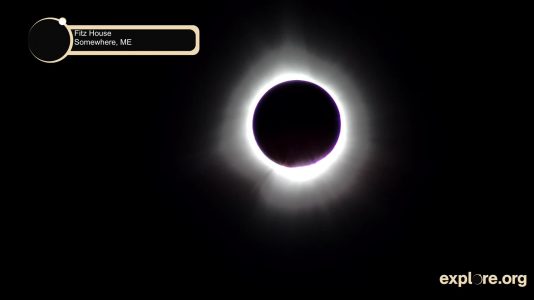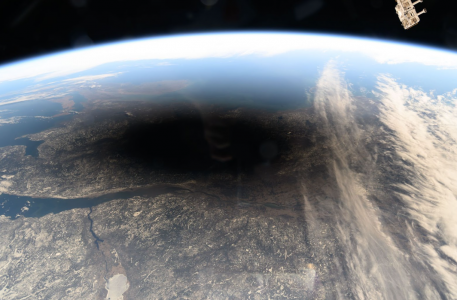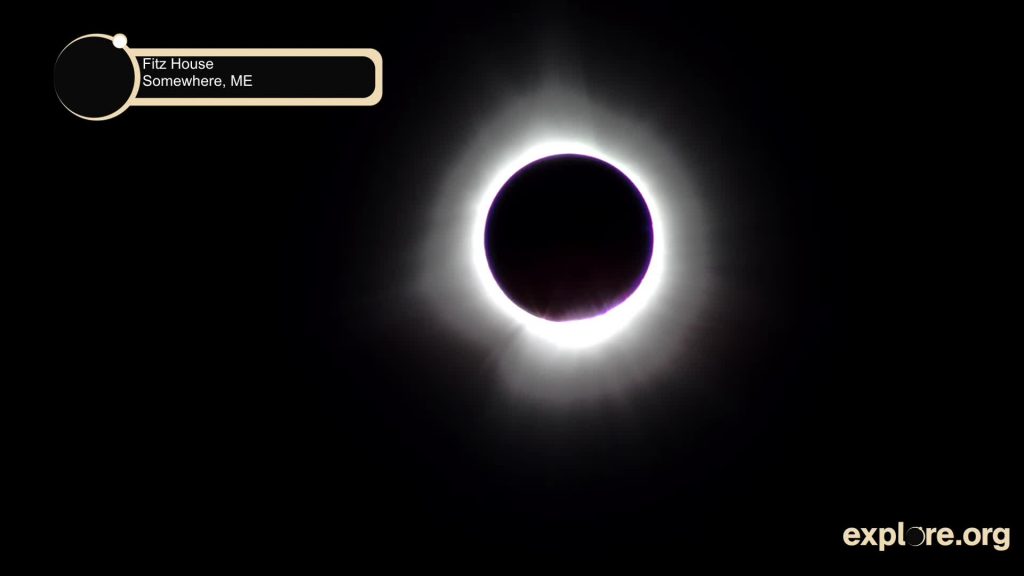By Mike Fitz
I was not prepared for what I saw.
I know people say that about total solar eclipses. I interviewed a NASA scientist who explained as much. Even though I never doubted their sincerity, people who have experienced total solar eclipses say it so much—“I wasn’t prepared”—that you wonder whether the sentiment is some type of collective exaggeration, an eclipse-inspired Mandela effect.
Friends, it is not. I was not prepared.
My planning for the April 8, 2024 total solar eclipse began about three years ago after learning that my house in Maine was within the eclipse’s path of totality. Early reconnaissance work was as easy as standing outside on a sunny afternoon in early April 2021 and April 2022 and (just to be sure) April 2023 to best understand where the Sun would be in the sky. Fortunately, a spot in the driveway provided a clear view to the southwest where the eclipse would wax and wane. Might a webcam view become possible too? I thought so, and the explore.org team concurred.
So on April 8 I plugged in a webcam, pointed it toward the Sun, connected with a camera operator (thank you, CamOp Arya for driving the cam), and waited under brilliant clear skies.
I had seen eclipses before-a total lunar eclipse over Pinnacles National Park in California, a partial lunar eclipse from Katmai National Park in Alaska, and a partial solar eclipse from Stehekin in Lake Chelan National Recreation Area in Washington. The eclipsed object in each, though, whether the Sun or the Moon, remained visible throughout.
The partial solar eclipse I experienced in Stehekin prepared me to expect changes in air temperatures and daylight. During the peak of the 2017 eclipse, I felt the air cool as the sun’s intensity lessened. I heard a nighthawk, a typically crepuscular and nocturnal bird, call from the sky. Perhaps there would be a chance to observe similar phenomena as the 2024 eclipse began.
Eclipses always seem to begin slowly. For nearly an hour, I could feel or see little change except for a growing cleft in the Sun. About 20 minutes before totality, with greater than 75 percent of the Sun covered by the Moon, the remaining light shifted to a dull hue like that of a lightbulb which is not bright enough for the room. I felt the temperature decline soon after. In the waning minute before totality, daylight faded to that given by a bright full moon. The air got colder still.
The experience was fascinating, but totality during a solar eclipse is something entirely different, they say. Even 99 percent coverage of the Sun by the Moon isn’t the same, they say. I watched and wondered. Is that true?
At its thinnest crescent, the sun remained too bright to view without proper eye protection. The Sun’s final arc glowed through my eclipse glasses. Then the lights went out.
It happened so suddenly. A shadow traveling at 2,000 miles per hour swept over the land. The Sun vanished. I gasped with an almost unconscious response.

Snapshot from CamOp Orion of totality during the April 8, 2024 eclipse.
I thought I could take good photos. I couldn’t. I thought I could focus my mind to somehow slow my perception of time to prolong the experience. I couldn’t. I thought I’d try to listen for behavioral changes in wildlife. I didn’t.
Not during totality. I could only look with awe.
The Sun’s corona glowed in a halo of wispy light around the moon. Baily’s beads twinkled on the Moon’s edges. Mercury, Venus, and Jupiter appeared. The blue-black sky at zenith faded to orange on the far horizons, all horizons, like the final radiance of long past sunset.

The Moon’s shadow covers portions of Canada and the U.S. on April 8, 2024 as seen from the International Space Station. The view looks east. Maine and New Brunswick are centered under the Moon’s shadow. The Saint Lawrence Seaway is the wedge of water at left and slightly below the Moon’s shadow. The Atlantic Ocean occupies the top section of Earth. Photo courtesy of NASA.
But more than anything, it is the blackness of the Moon that I can’t get out of my head.
I’ve been in caves. I’ve led tours where I’d purposely turn out all lights to experience complete darkness, a darkness that your eyes can never adjust to. That experience removes all objects from your sight. Totality of the eclipse was different. Light remained. The Sun should have been there. It was there, as was the Moon, but the effect was so outside my normal experience that it almost defied my senses. The Sun—the brightest object I can directly perceive with my own senses–was replaced by the blackest object I’ve ever seen. The Moon became a heavenly body defined by its absence of light.
I went to bed that night thinking about it. I woke the next morning thinking about it. I’m thinking about it now, days later.
Totality ended, it seemed, as soon as it began. More than three minutes felt like 30 seconds or less. The Earth’s surface brightened the moment the Sun reappeared from behind the Moon. The look and feel of the land returned to normal within minutes.
My eclipse photos are blurry. I think the shutter speed was a little too slow or perhaps the focus was slightly off. Perhaps that is unimportant. No photo or video truly captures the experience of a total solar eclipse as you sense it. I’m not sure what to compare it to. It is like the profound difference between looking at a photo of a loved one and holding them in your arms.
Even now, I could fool myself into questioning whether I truly saw what happened. The Sun’s vanishing act was so sudden. Its most intense light was erased. If there is a moment when a person can be star-struck, this was it.
I was not prepared.





